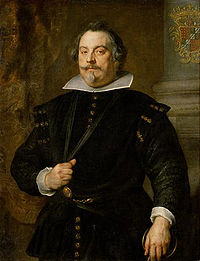- Francisco de Moncada, 3rd Marquis of Aitona
-
 Francisco de Moncada, 3rd Marquis of Aitona, (1586 - 1653), Count of Ossona, from an 11th Century noble Catalan family intervening in the South of Spain, Sicily and the Byzantine Empire, after the 13th and 14th Centuries. Painting by Anthonis Van Dyck, (Antwerp, 1599 - London, 1641), disciple of Peter Paul Rubens, a diplomat at the service of the Spanish Crown, while Francisco de Moncada was a Governor in the Spanish Netherlands, kept at the Kunsthistorisches Museum, Vienna, Austria
Francisco de Moncada, 3rd Marquis of Aitona, (1586 - 1653), Count of Ossona, from an 11th Century noble Catalan family intervening in the South of Spain, Sicily and the Byzantine Empire, after the 13th and 14th Centuries. Painting by Anthonis Van Dyck, (Antwerp, 1599 - London, 1641), disciple of Peter Paul Rubens, a diplomat at the service of the Spanish Crown, while Francisco de Moncada was a Governor in the Spanish Netherlands, kept at the Kunsthistorisches Museum, Vienna, Austria
Francisco de Moncada (in Catalan: Francesc de Montcada i Montcada), 3rd Marquis of Aytona, (1586 - 1635) was a Spanish diplomat, soldier and writer of the early 17th century. He was also a governor of the Spanish Netherlands.
Contents
Early life
Moncada, Ambassador in Germany and Governor at the Spanish Netherlands, a General and Commander of the Spanish-Flemish Armies, and a brilliant medieval historian, was born in Valencia to Gastón de Moncada, 2nd Marquis of Aitona,( 1554 - 1626), Ambassador to Rome Viceroy of Sardinia, 1590 - 1595, Viceroy of Aragon,1603 - 1610, and his wife Cataline de Moncada (her maiden name) baroness of Callosa. He was taught as a child of the great works of both chivalry and the troubadours, especially Joanot Martorell's Tirant lo Blanch which influenced Miguel de Cervantes so much that he praises it in Don Quixote.
Literary work
Moncada wrote Expedicion de Catalanes y Argoneses al Oriente about the Catalan Company. This history gives an account of the followers of Roger de Flor in their cooperation and fighting the Byzantine Empire and later their capture of the Duchy of Athens.Editions: (Barcelona, 1623; Madrid, 1777, 1805, 1883;around 97 pages, Paris, 1841, in "Tesoro de los historiadores espanoles").
Moncada also wrote Vida de Anicio Manlio Torquato Severino Boecio. This Roman politician from an illustrious Imperial family of the 6th Century, can be found at Wikipedia under Anicius Manlius Severinus Boëthius, commonly called Boethius (ca. 480 – Senator 505 - Consul 510 - 524 or 525, executed by Ostrogoth king of Rome Theodoric the Great when suspected of connivence with the Byzantine Empire, a matter treated before by XIV - XV Century Spanish Humanists. This work was not published until after Moncada's death, first going to press at Frankfurt, Germany in 1642.
Government service
Moncada served as the Spanish ambassador to the Holy Roman Emperor for a time. The emperor Ferdinand II was very impressed with him.
He served as a counselor to Princess Isabella Clara Eugenia of Spain, regent of the Spanish Netherlands. While serving in Brussels he tried to convince King Philip IV of Spain to transfer the general management of affairs in his Netherlands possessions to Brussels and remove any responsibility for such matters from the government in Madrid. His proposals to give the various peoples in the Netherlands still under Habsburg rule more say in their governmental affairs were rejected.
He was made the commander-in-chief of the Spanish navy in the Netherlands in 1630. On 12-13 March 1631, his seamen were defeated at the Battle of the Slaak, the commander being then a Catholic member of the House of Orange-Nassau, namely Count Jan VIII van Nassau-Siegen, (Dillenburg, Germany, 1583 - Count successor 1623 - Siegen, Belgium, 27 September 1623).
 Catholic Count Jan VIII van Nassau-Siegen, (Dillenburg, Germany, 1583 - married at Brussels, 13 August 1618, Ernestine Yolanda de Ligne D'amblisse, (1594 - 1668) - Count successor 1623 - Siegen, Belgium, 1638), was in charge of the Spanish-Flemish Fleet defeated by Dutch, Scotts and English mercenaries, September 1631, at the Battle of the Slaak, fighting on behalf of the Spanish Governor Francisco de Moncada, 3rd Marquis of Aitona, (1586 - 1635). Rijksmuseum Amsterdam, 30x24.6 cm
Catholic Count Jan VIII van Nassau-Siegen, (Dillenburg, Germany, 1583 - married at Brussels, 13 August 1618, Ernestine Yolanda de Ligne D'amblisse, (1594 - 1668) - Count successor 1623 - Siegen, Belgium, 1638), was in charge of the Spanish-Flemish Fleet defeated by Dutch, Scotts and English mercenaries, September 1631, at the Battle of the Slaak, fighting on behalf of the Spanish Governor Francisco de Moncada, 3rd Marquis of Aitona, (1586 - 1635). Rijksmuseum Amsterdam, 30x24.6 cm
In 1632 he was put in charge of all Spanish forces in the Netherlands. In 1634 he was made governor of the Spanish Netherlands on the death of Spanish Netherlands Governees Isabella Clara Eugenia , (born 1566*, in December 1633.
He died of illness in 1635 at the Battle of Goch, North Rhine-Westphalia, Germany, 51°41′2″N 6°9′43″E, very near the actual Dutch-German border.
See also
References
- Introduction to Frances Hernandez' translation of Moncada's Catalan Chronicle.
External links
 Media related to Francisco de Moncada, 3rd Marquis of Aitona at Wikimedia Commons
Media related to Francisco de Moncada, 3rd Marquis of Aitona at Wikimedia Commons- "Francisco De Moncada". Catholic Encyclopedia. New York: Robert Appleton Company. 1913. http://www.newadvent.org/cathen/10476a.htm.
- Text of Francisco's Catalan Chronicle (in Spanish) http://manybooks.net/titles/moncadad13511351613516-8.html
Categories:- 1586 births
- 1635 deaths
- People from Valencia
- Spanish nobility
- Marquesses of Aitona
- Valencian writers
- Spanish writers
Wikimedia Foundation. 2010.
